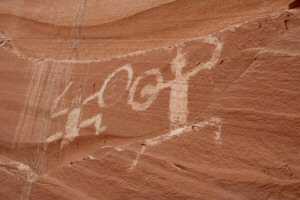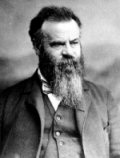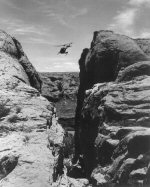While the Lake Powell area is in one of the more isolated parts of the United States it does have a long history. This history will be covered in four sections: pre-Columbian, Spanish Era, Explorers and Settlers, and the Dam Era.
PRE-COLUMBIAN HISTORY
 Native Americans occupied the Glen Canyon region over 2000 years ago. The Anasazi settled in the Four Corners Area, farming in areas by the Colorado River and its' tributaries. There are many archeological sites on Lake Powell, the most famous of which is Defiance House in Forgotten Canyon. Petroglyphs are also abundant in the area. The Anasazi vanished from the region around 700 years ago. Several other tribes, including the Navajo, Ute, and Paiute moved into the area and lived in and around the Lake Powell Region. All archeological sites are protected by federal law. Do not deface or remove any archeological items.
Native Americans occupied the Glen Canyon region over 2000 years ago. The Anasazi settled in the Four Corners Area, farming in areas by the Colorado River and its' tributaries. There are many archeological sites on Lake Powell, the most famous of which is Defiance House in Forgotten Canyon. Petroglyphs are also abundant in the area. The Anasazi vanished from the region around 700 years ago. Several other tribes, including the Navajo, Ute, and Paiute moved into the area and lived in and around the Lake Powell Region. All archeological sites are protected by federal law. Do not deface or remove any archeological items.
SPANISH ERA
In July of 1776 an expedition led by Fathers Dominguez and Escalante left Santa Fe, New Mexico in search of a route to Monterey, California. They only made it as far as western Utah before being forced to return due to the onset of winter. On their return trip they tried to find a ford over the Colorado River. They first approached the river at what is now Lees Ferry on October 26. They could not ford there and continued upstream. Several days later they camped near Wahweap Lodge before continuing upstream looking for a crossing. They found their ford under what is now Padre Bay on November 7. This was to become known as "The Crossing of the Fathers".
EXPLORERS AND SETTLERS
 The Mormons who settled in the northern portion of Utah during the Mexican War began exploring and settling to the south. This would be the impetus for much of the exploration of Glen Canyon. But the most famous, and probably the most daring, were the two geologic expeditions made by John Wesley Powell's group in 1869 and 1871. Powell, shown to the right, had lost an arm in the recent U.S. Civil War. They took wooden boats down the Green and Colorado Rivers through the then unexplored Glen and Grand Canyons. Powell named Glen Canyon because of the peaceful side canyons he found. Glen Canyon gave Powell and his crew a respite from the rough rapids found above and below Glen Canyon. Powell later would go on to head the U.S. Geological Survey.
The Mormons who settled in the northern portion of Utah during the Mexican War began exploring and settling to the south. This would be the impetus for much of the exploration of Glen Canyon. But the most famous, and probably the most daring, were the two geologic expeditions made by John Wesley Powell's group in 1869 and 1871. Powell, shown to the right, had lost an arm in the recent U.S. Civil War. They took wooden boats down the Green and Colorado Rivers through the then unexplored Glen and Grand Canyons. Powell named Glen Canyon because of the peaceful side canyons he found. Glen Canyon gave Powell and his crew a respite from the rough rapids found above and below Glen Canyon. Powell later would go on to head the U.S. Geological Survey.
John D. Lee established Lees Ferry in 1871 on the orders of Brigham Young, leader of the Mormon Church. Lee was hiding from the law for his alleged involvement in the massacre of some pioneers traveling through Utah. Lee was captured and executed in 1877. The Lonely Dell Ranch buildings still exist and can be visited. This crossing would be used until 1929 when Navajo Bridge opened over the Colorado River south of Lees Ferry. Lees Ferry is now is the starting point for people going up river the 15 miles to Glen Canyon Dam and down river through the Grand Canyon.
 Another daring expedition was the Hole-In-The-Rock expedition. The photo to the right shows Hole-In-The-Rock before Lake Powell. Mormon pioneers set on colonizing southwest Utah made there way to this point in 1879. They dug, blasted, and filled a rough road down 2000 feet to the Colorado River. The grade was approximately 25% but as steep as 45% at some places. It took six weeks to complete the road and another three weeks to lower the wagons down the road. Charles Hall, later to found Halls Crossing about 30 miles upstream, had to build a ferry to cross the Colorado River. After this they had to build another road to get up Grey Mesa. After a six month journey the hearty pioneers reached their destination and founded the town of Bluff, Utah on the San Juan River.
Another daring expedition was the Hole-In-The-Rock expedition. The photo to the right shows Hole-In-The-Rock before Lake Powell. Mormon pioneers set on colonizing southwest Utah made there way to this point in 1879. They dug, blasted, and filled a rough road down 2000 feet to the Colorado River. The grade was approximately 25% but as steep as 45% at some places. It took six weeks to complete the road and another three weeks to lower the wagons down the road. Charles Hall, later to found Halls Crossing about 30 miles upstream, had to build a ferry to cross the Colorado River. After this they had to build another road to get up Grey Mesa. After a six month journey the hearty pioneers reached their destination and founded the town of Bluff, Utah on the San Juan River.
In 1883 Cass Hite began searching for silver used by the Navajo for making there jewelry. He didn't find silver but he did find gold. He named the place "Dandy Crossing" which will later be named Hite, Utah. The settlement is now under the waters of Lake Powell near the present site of Hite Bay. Many other prospectors would follow Hite into the area.
Robert Stanton first came to Glen Canyon in 1889 looking for a railroad route but later formed a mining company that attempted in 1901 to extract gold, to no avail, from the area around Bullfrog Creek using a steam driven dredge.
Charles Spencer first attempted, in 1909, to extract gold from the San Juan. Unsuccessful, he then attempted to extract gold from the sand and mud at Lees Ferry. To accomplish this he hauled a steamboat, in pieces to build at Lees Ferry. The plan was to use the steamboat to haul coal from Warm Creek down to Lees Ferry for use in operating the mining machinery. The plan was given up when it was discovered that the steamboat could only carry enough coal to fuel itself on the round trip to Warm Creek. Remnants of the steamboat can still be seen in the Colorado River slightly upstream from Lees Ferry.
The Zahn brothers, Otto and Hector, mined gold in the San Juan in the early 1900's. They built a road that extended into what is now Zahn Bay on the San Juan River arm.
Another famous expedition was the Cummings-Douglass Expedition to Rainbow Bridge. Two Native American guides, Nasja Begay and Jim Mike led the expedition here in 1909. A year later President William Howard Taft declared the site an National Monument. Until Lake Powell the trip to Rainbow Bridge was a difficult journey but a few famous people made the trek, including Theodore Roosevelt and Zane Grey. River runners began to bring tourists through Glen Canyon for pleasure starting in the 1930's. Up river runs from Lees Ferry to Rainbow Bridge were begun in the 1940's. These river trips would continue until the formation of Lake Powell.
DAM ERA
The future of Glen Canyon changed in 1922 with the Colorado River Compact. This divided the Colorado River drainage into the upper and lower basins, with Lees Ferry being the dividing point. Water allocations were given to the states the Colorado River flows through and the upper basin states had to guarantee a certain amount of flow past Lees Ferry. This brought on the idea of a water storage project upstream from Lees Ferry. This would assure that the upper basin states could deliver the required allotment to the lower basin states.
The Colorado River Storage Project was approved by Congress in 1956 and included four dams, one of which was Glen Canyon Dam. Glen Canyon Dam Construction started in 1956 when President Dwight Eisenhower pushed a button in Washington, D.C. to set off the first blast in the wall of Glen Canyon. A new town, Page, Arizona, was built to house the construction workers. Glen Canyon Bridge was also begun at this time to replace the temporary walking bridge suspended over Glen Canyon. The bridge would be complete in 1959. Glen Canyon Dam was complete enough in 1963 to allow the diversion tunnels to be sealed on March 13, starting the formation of Lake Powell. The dam would be dedicated in 1966 by First Lady Lady Byrd Johnson. In 1972, Glen Canyon National Recreation Area was formed.

